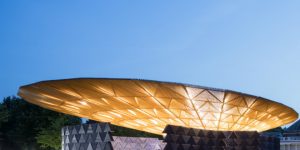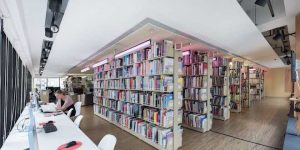Opera Gallery presents works by Korean artists Sung-Hee Cho, Kwangyup Cheon and Kazuo Shiraga at Art Stage Singapore 2018
Opera Gallery Singapore showcases Dansekhwa and Gutai artists

Sung-Hee Cho, ‘Cosmic Fog ll’, 2015, 137 x 97cm, mixed media
In recent years, the artworld has been a champion of modern and contemporary Korean art. Opera Gallery’s showcase at the upcoming edition of Art Stage Singapore 2018 is an indication that the spotlight is still shining bright, and that regional interest in the genre remains strong.
Highlighting the paintings of Korean artists Sung-Hee Cho (b. 1949) and Kwangyup Cheon (b. 1958), the gallery’s presentation is a study in sublime contrast and complement. Both Cho and Cheon trace their artistic roots to Dansaekhwa or the Monochrome Movement in 1960s-80s Korea, and there are more parallels in their artistic journeys. Both pursued fine art graduate studies in the US at the Pratt Institute in New York; Cho also studied at the Art Institute of Chicago and the Otis/ Parsons Art Institute, Los Angeles. As artists continuing in the Korean minimalist painting style however, where they diverge in stylistic approaches and inspiration speak subtly to the different timeless and contemporary forces that have shaped Korean culture today.
The tempered restraint of their works is the foil to the other star piece in Opera Gallery’s showcase, an early 1962 painting by the Japanese Gutai master Kazuo Shiraga (1925-2008). Gutai, the Japanese post-war avant-garde movement founded in Osaka in 1954, advocated originality and individualism. Its members sought to create a new authentic Japanese aesthetic that would redeem and restore Japanese culture from the mindless conformity that had seemingly led the country to war.
Gutai artworks embodied its literal translation of “concreteness” through direct interaction with a range of materials and physical processes. In striving for spirit to meet matter — to reveal “the scream of matter”, as written in the Gutai Art Manifesto — none came closer than Shiraga, who stomped fervently on his canvases with his feet, and later on, would suspend himself from the ceiling and allow gravity and motion to direct various parts of his body in painting.

Kazuo Shiraga, ‘Untitled’, 1962, oil on canvas
Painted in 1962 when Shiraga first began experimenting with his suspended technique, ‘Untitled’ captures this critical pivot in his practice. Unapologetically raw and pulsing with stark traces of his body shifting and mashing paint, the work is a visceral force in oil. At the centre, a smear of blood red — a colour that figures prominently in his oeuvre — ignites thoughts of guts, violence, and grotesque beauty.
Of the two, Kwangyup Cheon is more closely representative of the Dansaekhwa tendency in his aesthetics and philosophy. Dansaekhwa, the first modern art movement in Korea, produced layered, minimalist paintings that sought Korean essence through form, materiality and repetitive process. What distinguishes Cheon’s paintings is their unnaturally flat appearance, recalling woven textiles seen under a magnifying glass or a matrix of data streaming across a screen. From afar, they are coolly abstract works that belie their intensely menial creation; up close, the hundreds of thousands of uniform dots painted line by line reveal minute human imperfection and the strain of time.

Kwangyup Cheon, ‘Omni No. 2’, 2016, 161 x 131cm, oil and mixed media on canvas
Cheon developed his method of eliminating all elements but the most basic form — the dot — by observing how clusters of small dots were punched in sheets by a computer numerical control (CNC) programme in the mid-1990s. “Through this process,” he says, “the artwork gets closer to the purity of the three keywords: materiality, planarity, and neutrality.” Almost as if striving for a flat nothingness that can deny its own existence, his paintings evoke stillness and stoic silence.
The works of Sung-Hee Cho on the other hand, are vibrant embodiments of spirit. Like many Dansaekhwa-influenced artists such as Kim Minjung, Korean mulberry paper or hanji is a key component of Cho’s paintings. Known for collages made out of hand-torn circles layered with vivid oil pigments, Cho has always sought to preserve and highlight the material qualities of hanji in her practice. The three-dimensional effect makes her pieces evocative of blooming petals and freshly fallen blossoms that are transient, beautiful matter barely there but for a moment.

Sung-Hee Cho, ‘The Star in the Cosmos’, 2012, 227 x 182 cm, mixed media
Compared to the more coolly cerebral nature of Cheon’s work, Cho’s practice is grounded in warm sensuousness of Korean material culture. Her choice of materials and colours are strongly influenced by hanbok, Korean traditional dress, which have an intensity of colours, yet retain a soft, natural sensibility. There is also a lightness and hint of playfulness in Cho’s works not often perceived in Korean minimalist painting that may be attributed to her childhood source of inspiration: “I have a strong memory of hanbok from my childhood. When I was young, my mother always wore hanbok and I followed her to the hanbok shop many times. Unlike most people, my mother liked unique combinations of colours and naturally, my colour sense took after hers.”
Both Gutai and Dansaekhwa were movements in search of a national aesthetic that sought to reinvigorate society and catalyse change through art. The works of Shiraga, Cheon and Cho reveal the delicate juxtapositions and synchronicities in colour, matter and philosophy that speak richly of the modern artistic and cultural traditions in Japan and Korea.
More information at operagallery.com/singapore.
ART REPUBLIK is an official media partner of Art Stage Singapore. Come visit our booth at the fair!
This article was written by Rachel Ng for Art Republik Issue 17.









